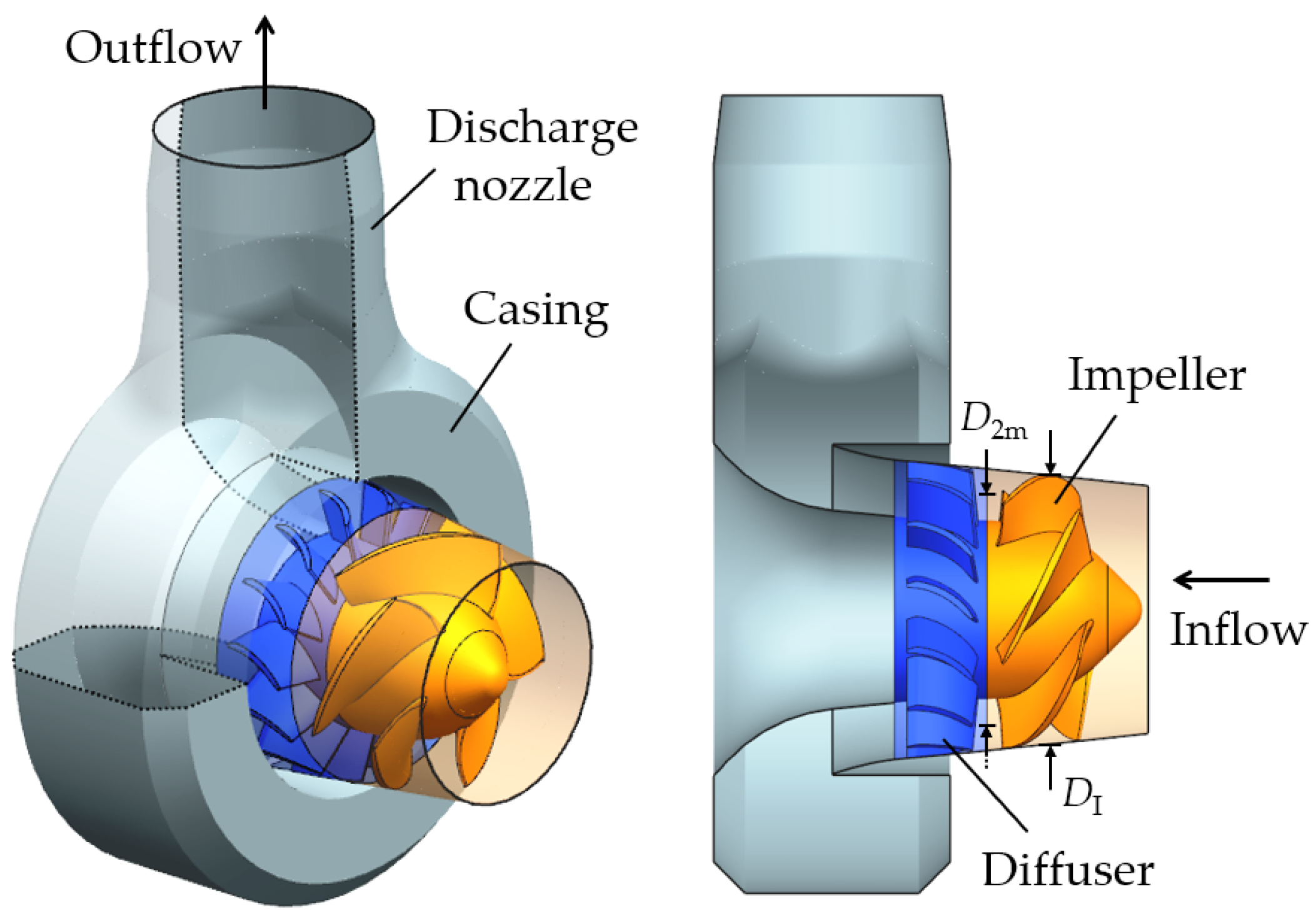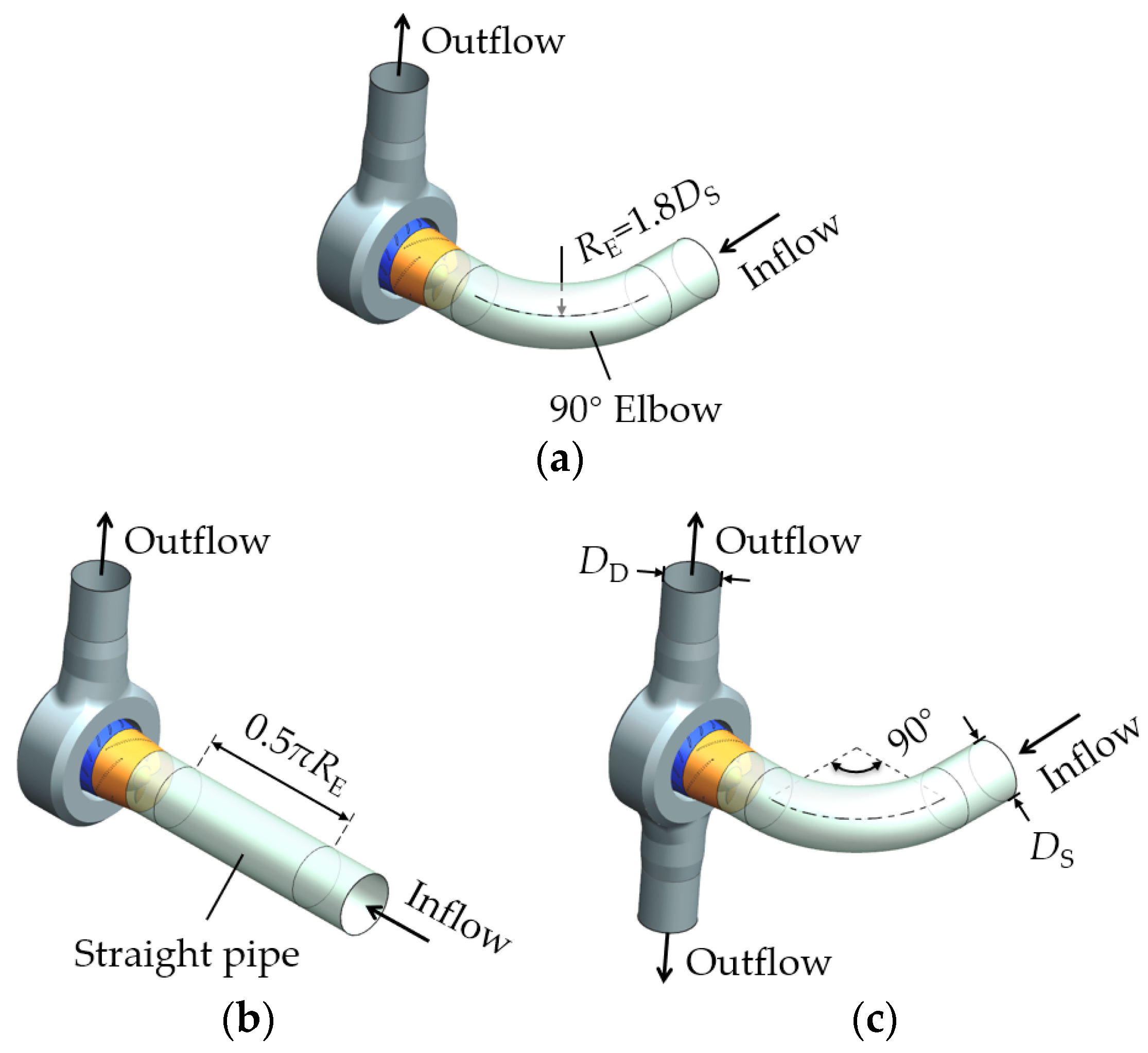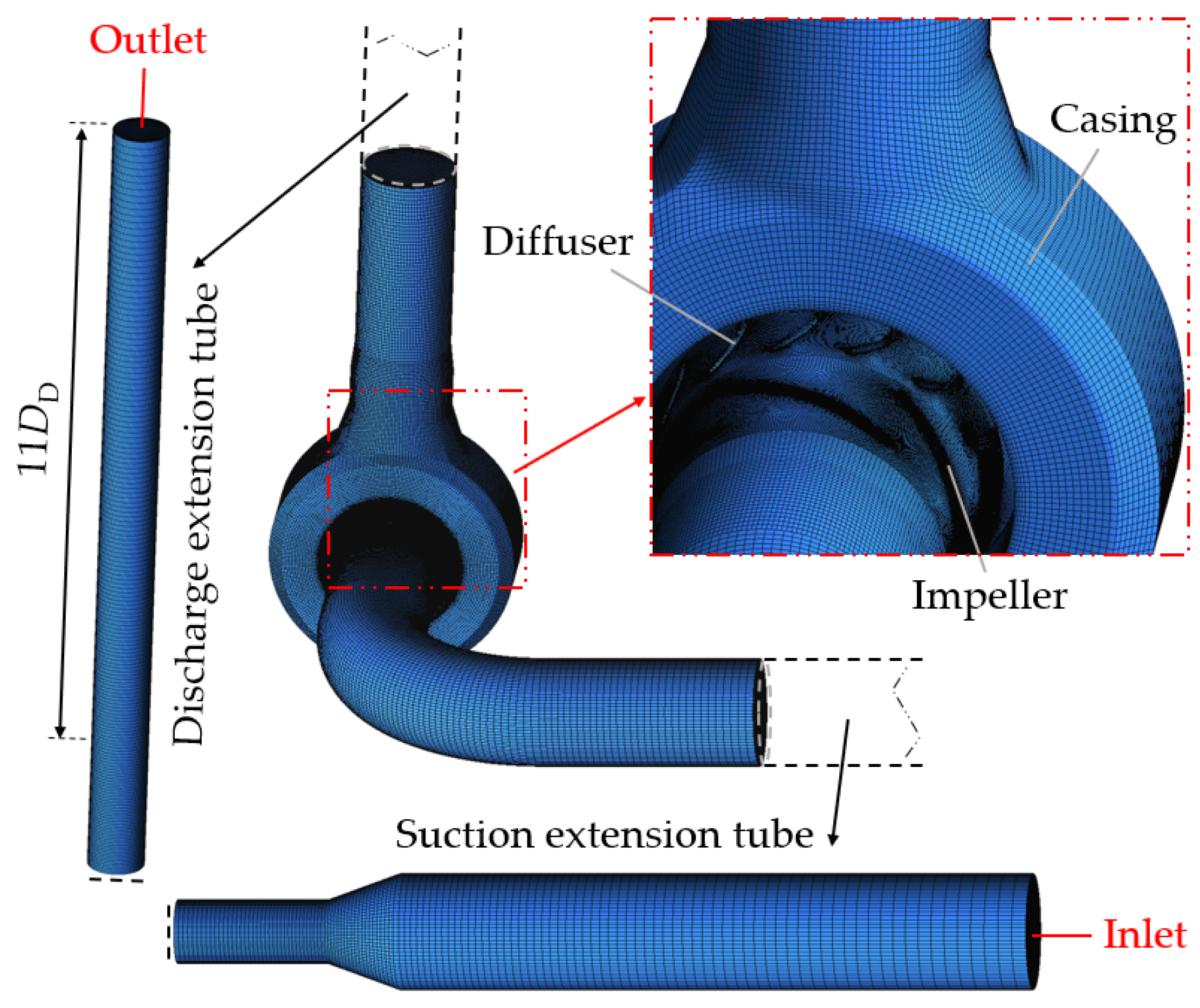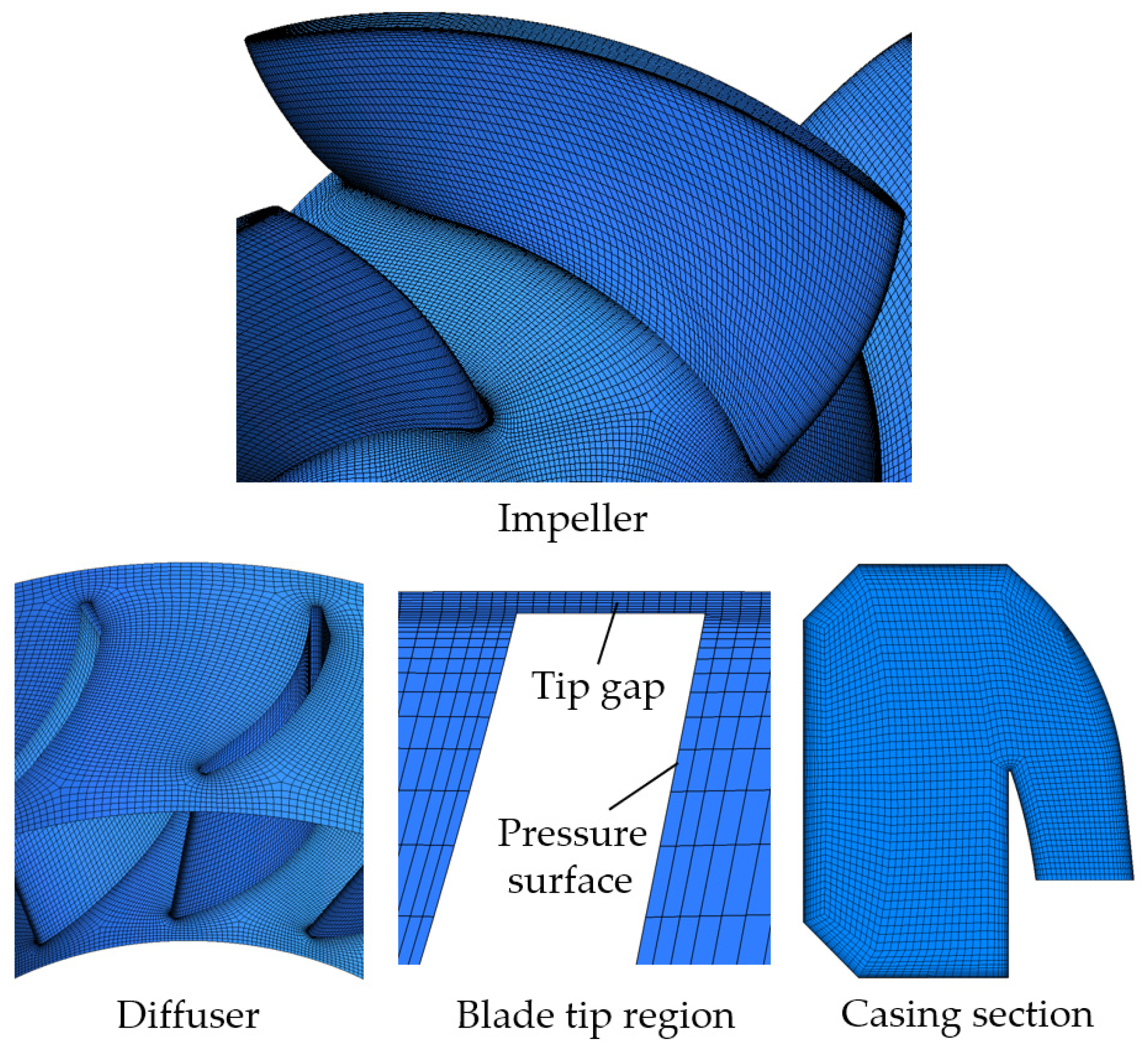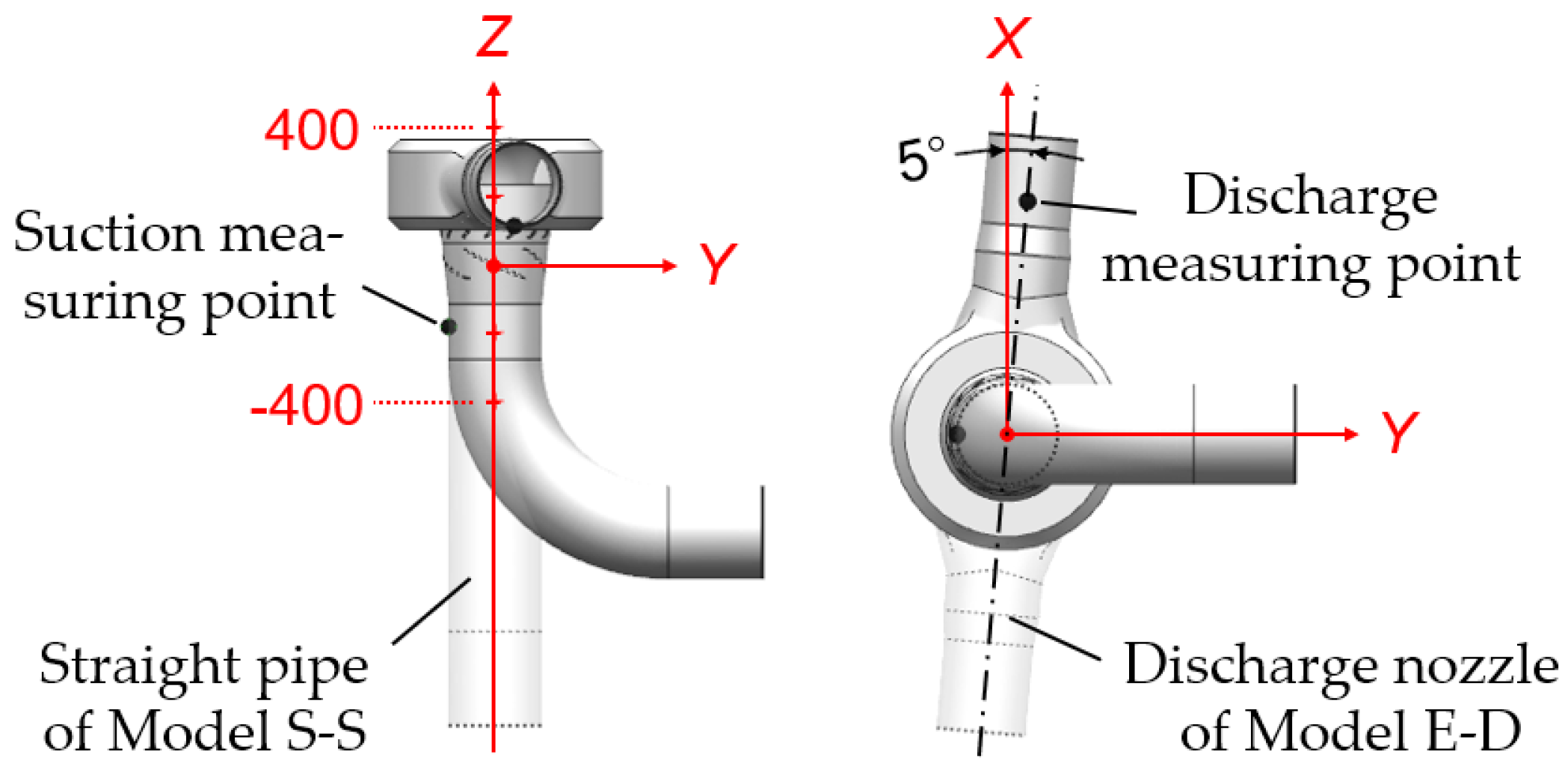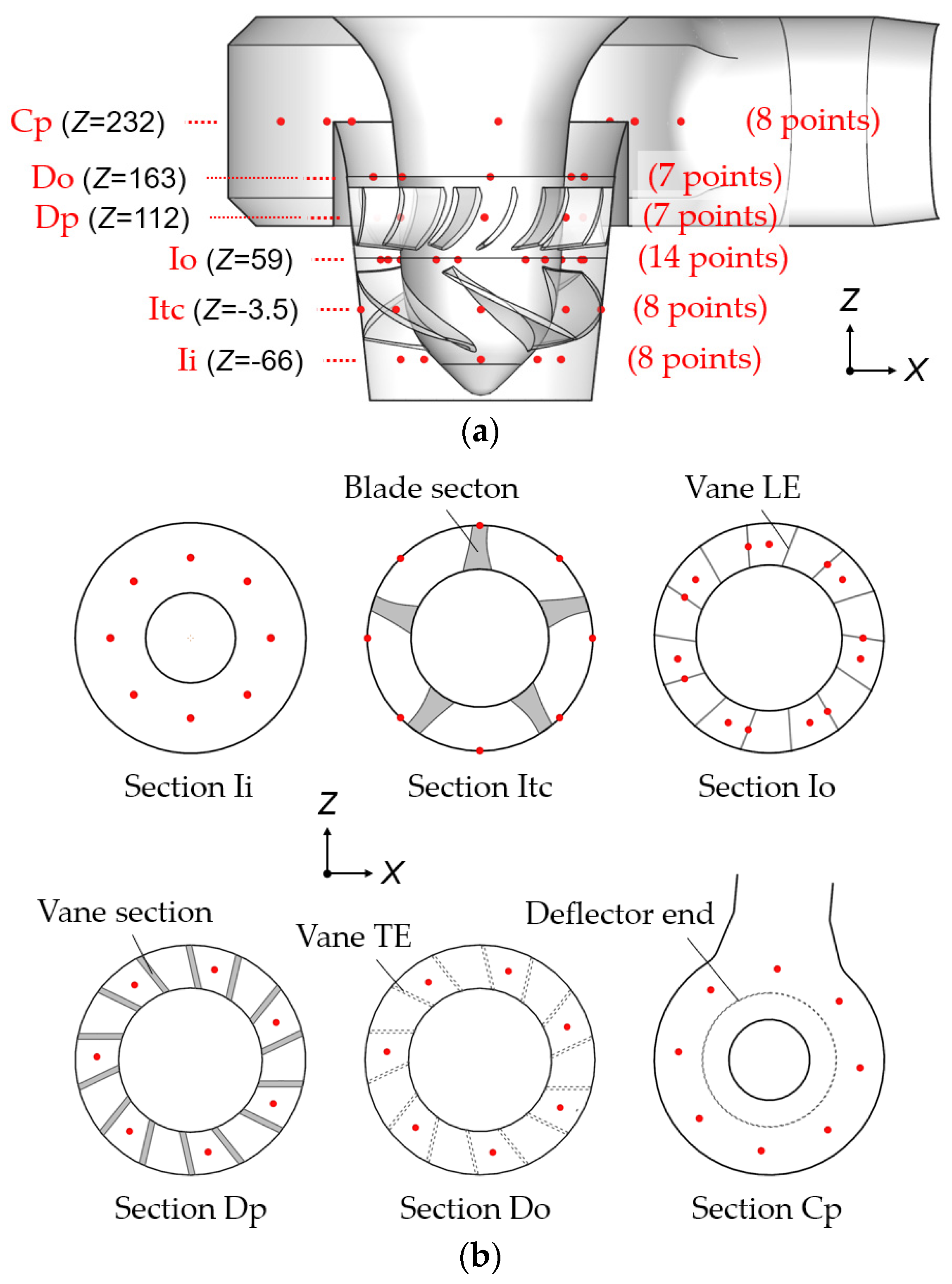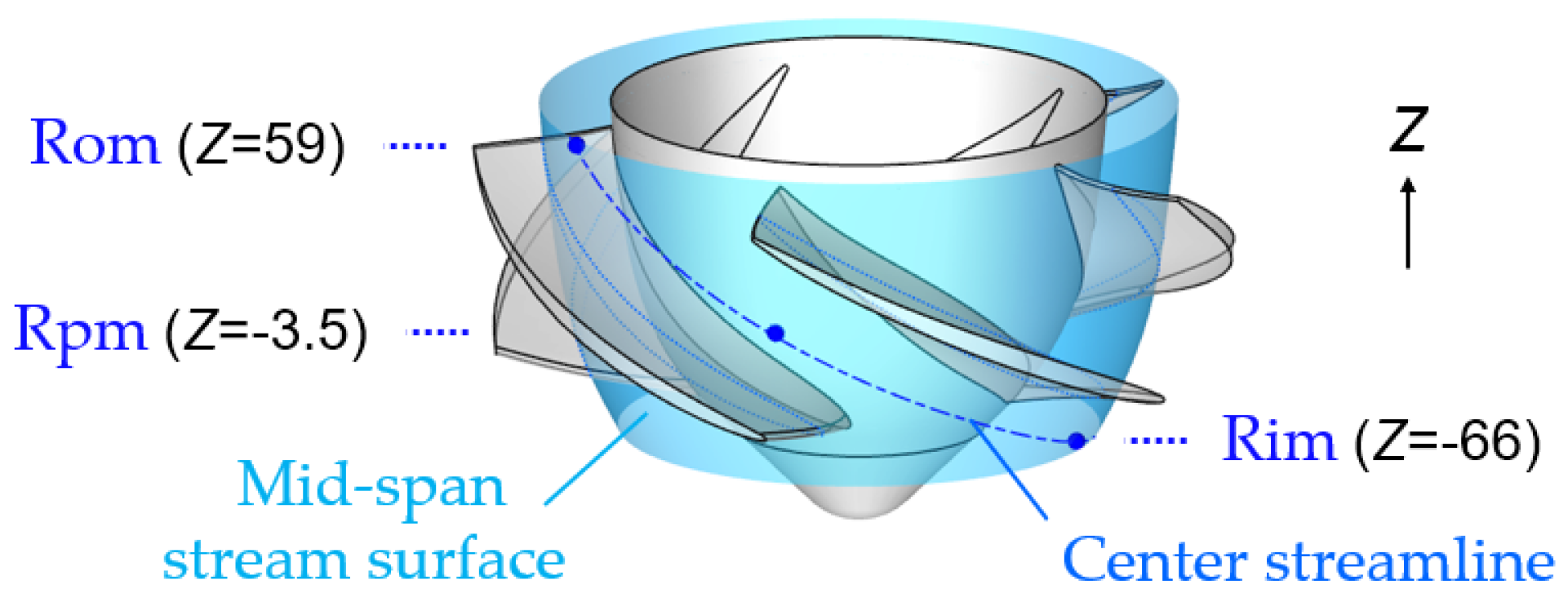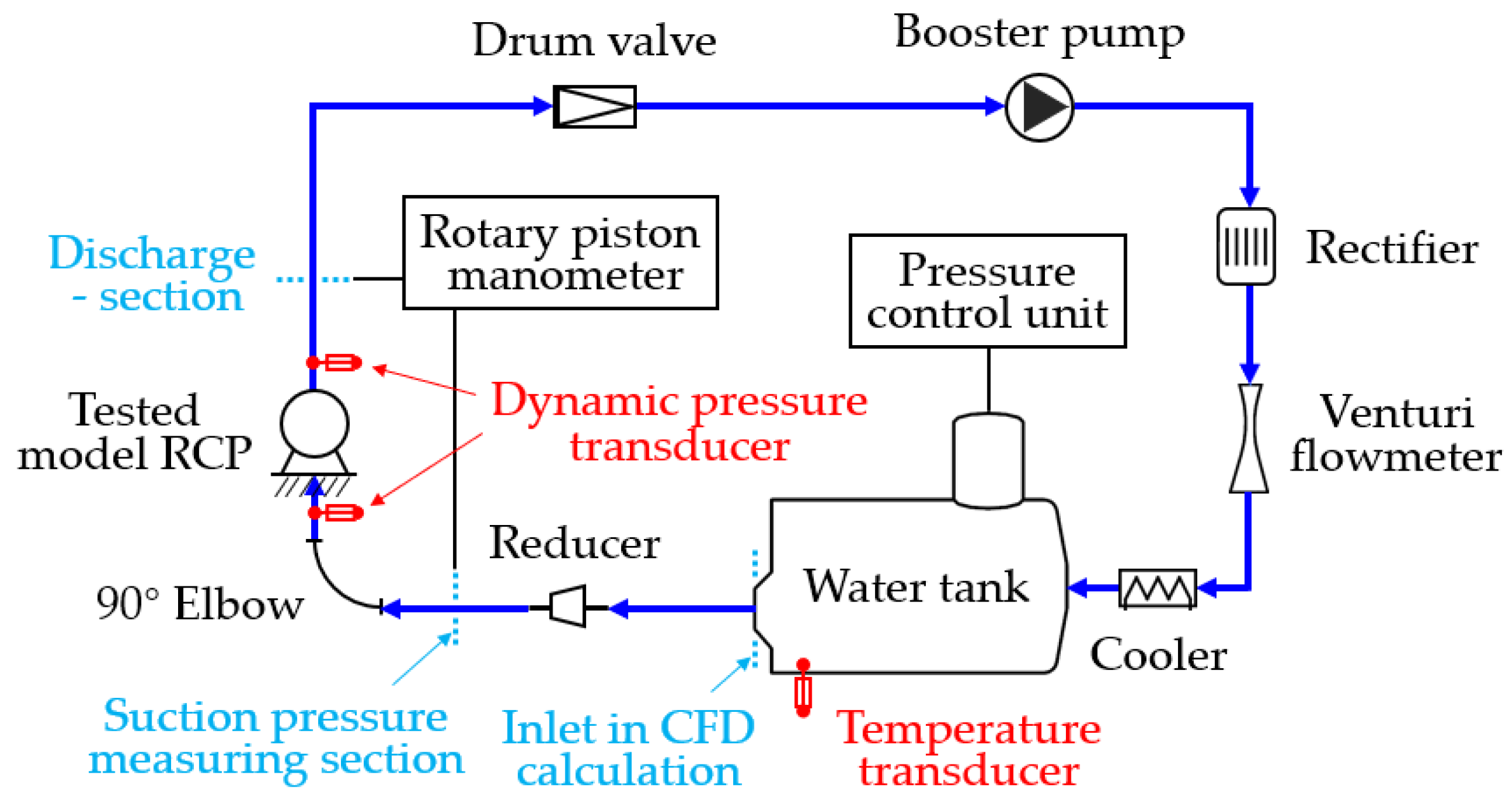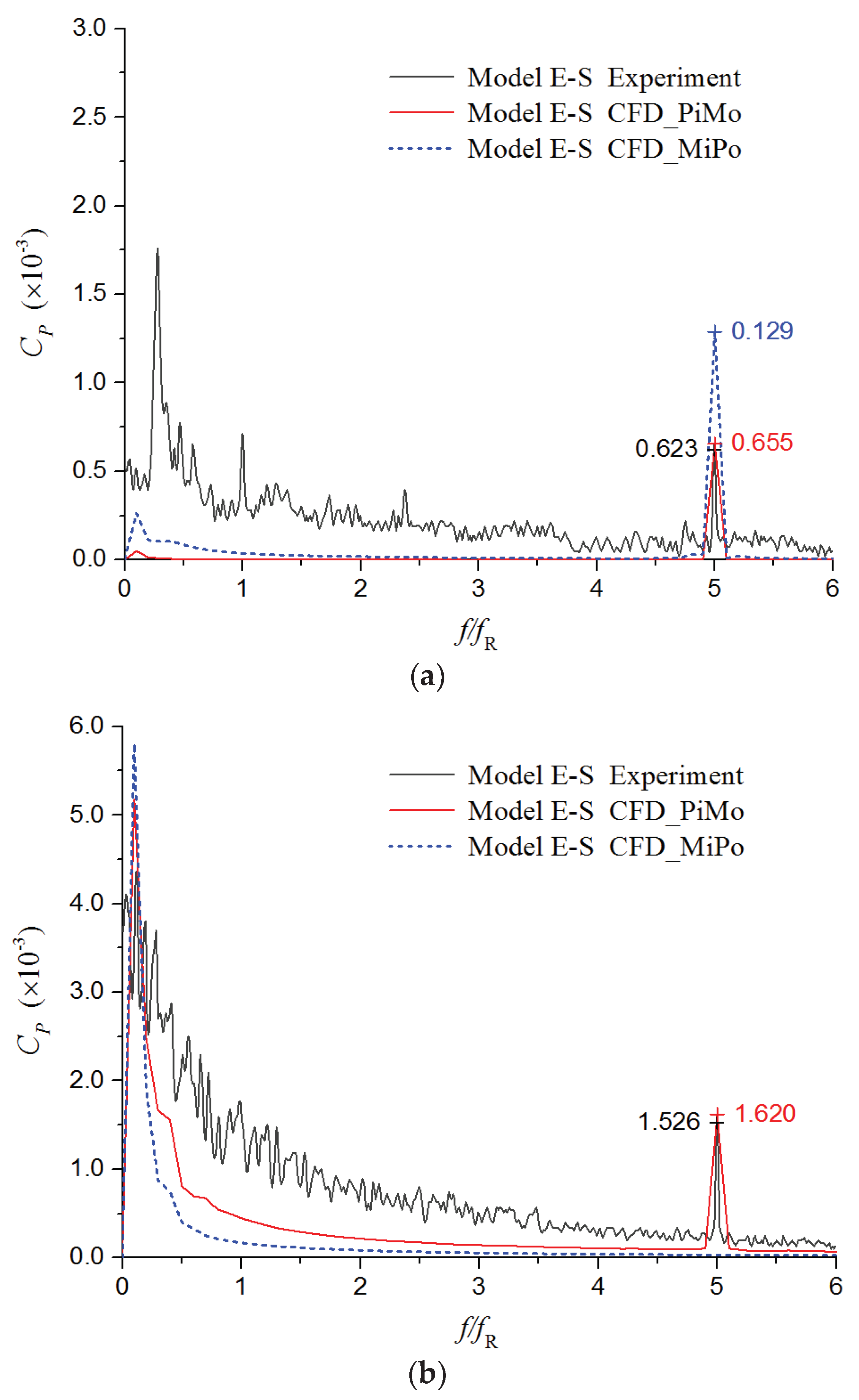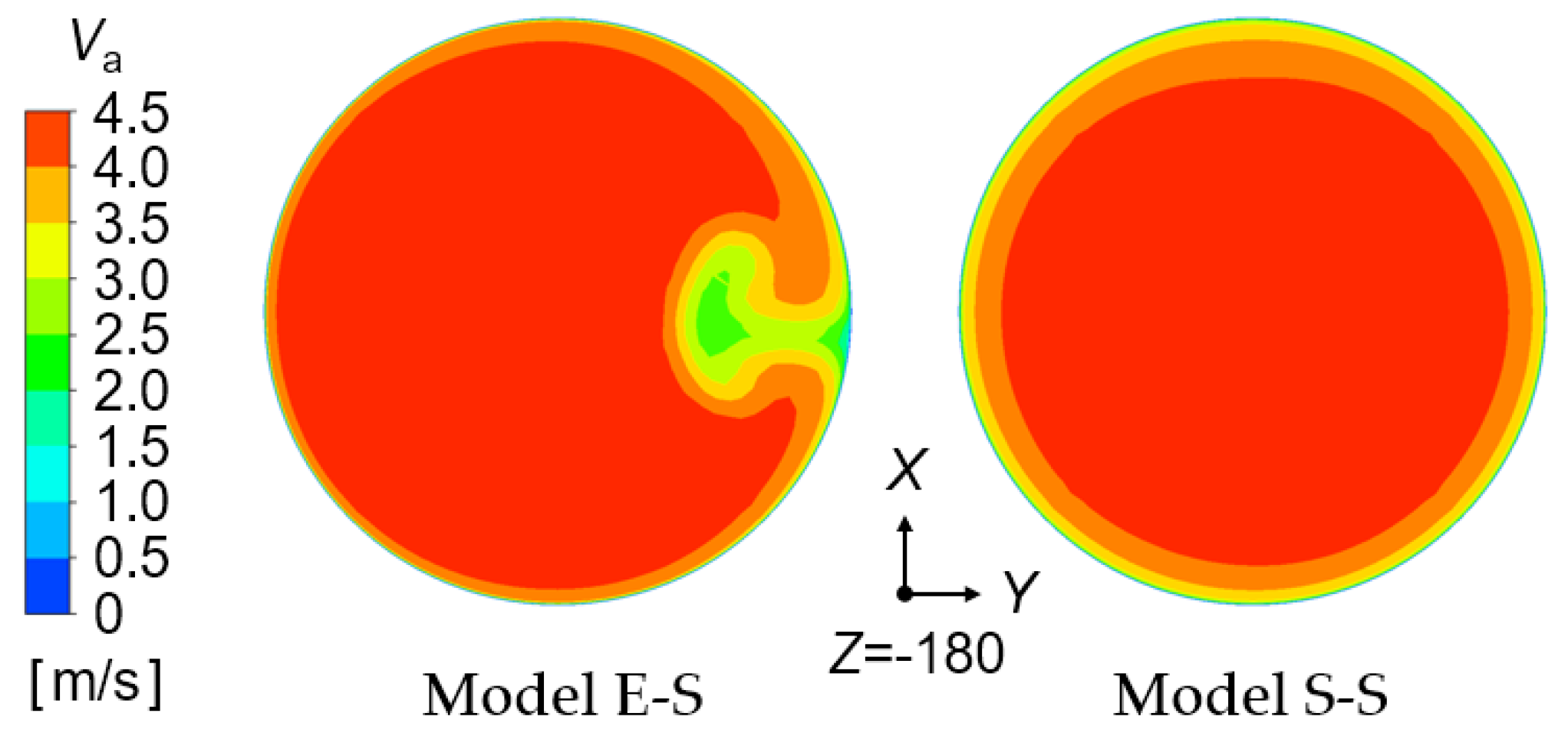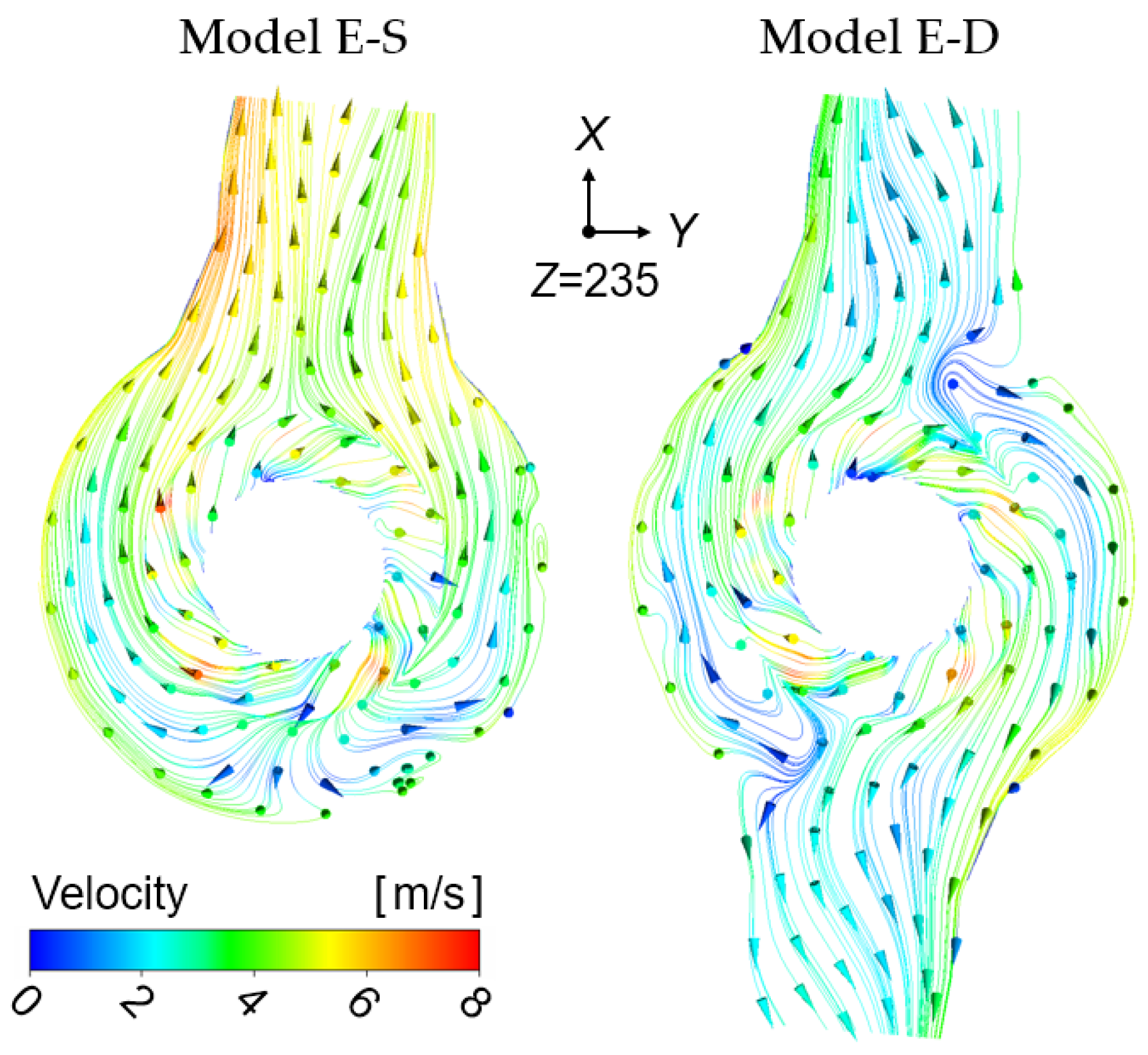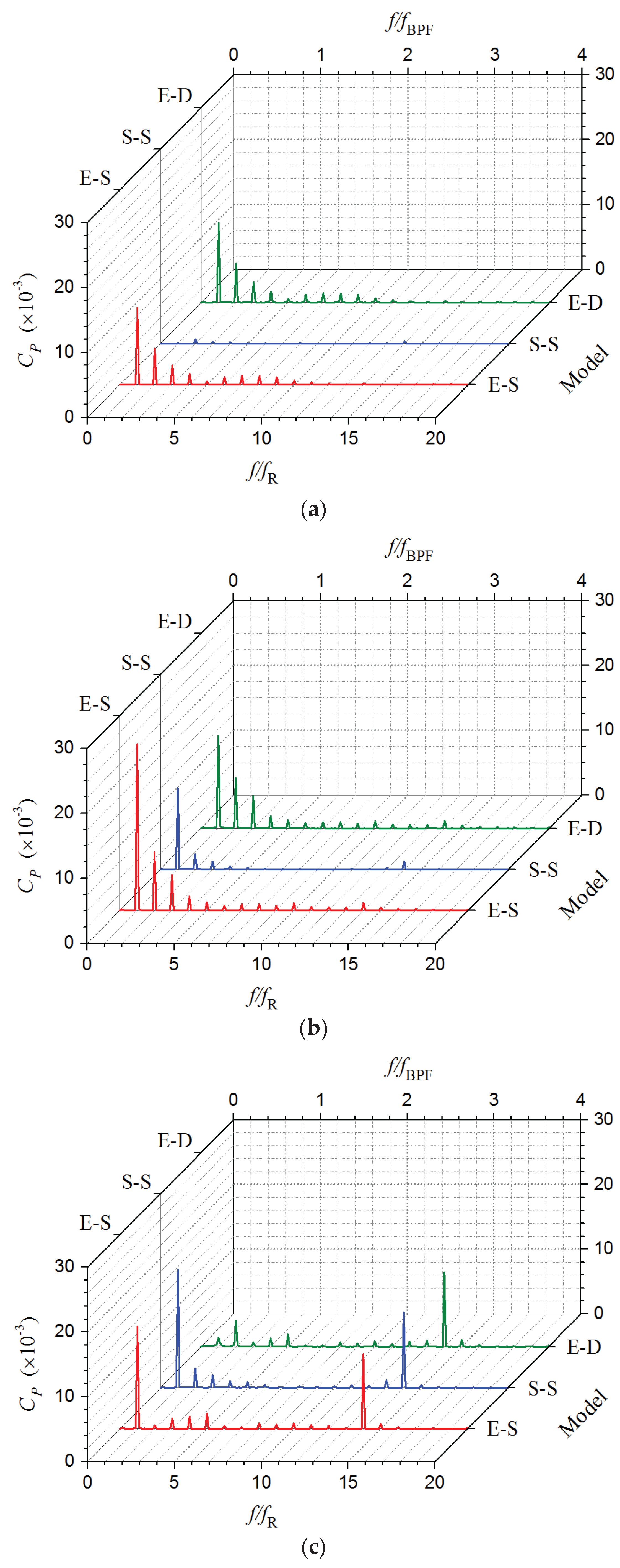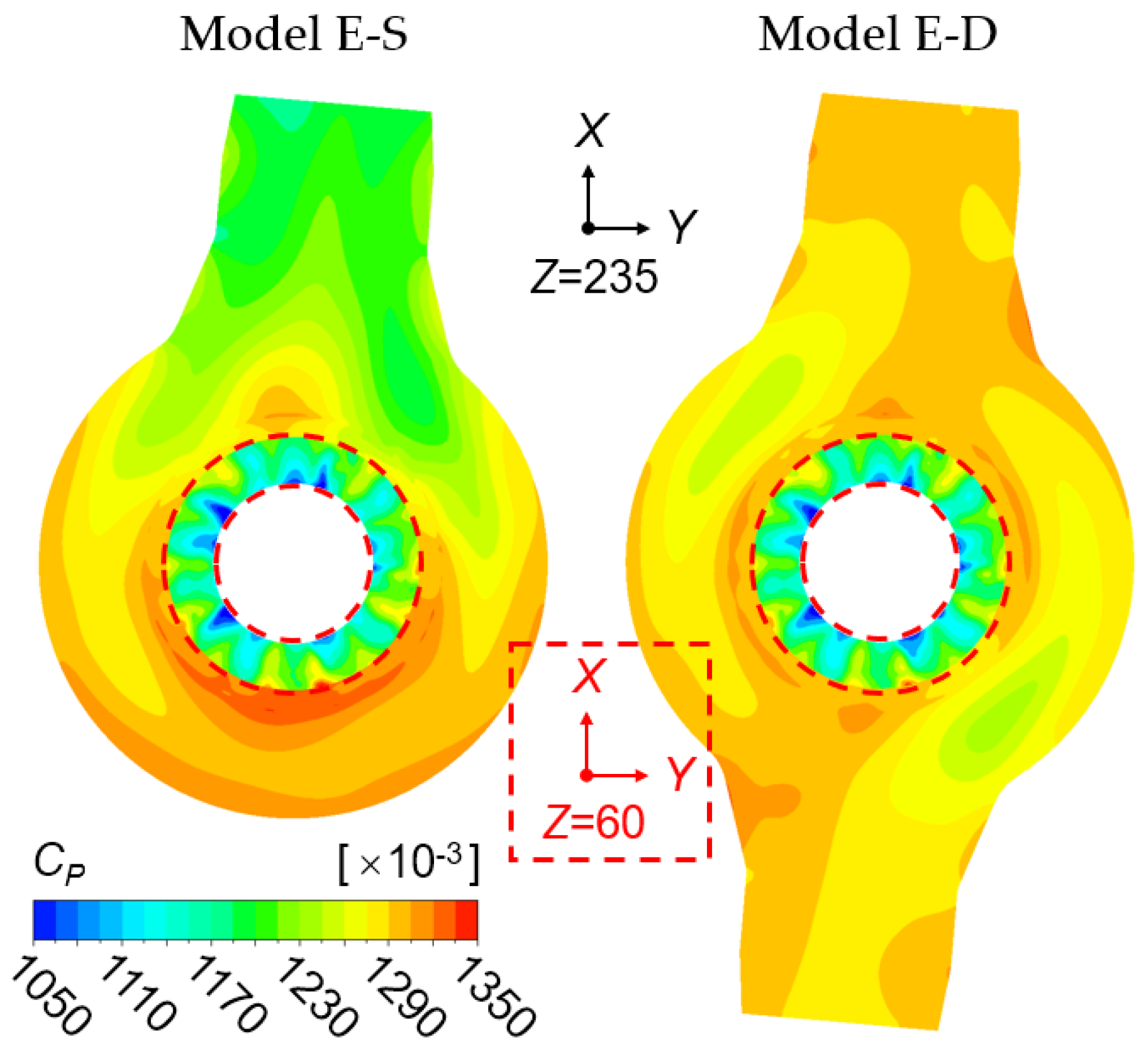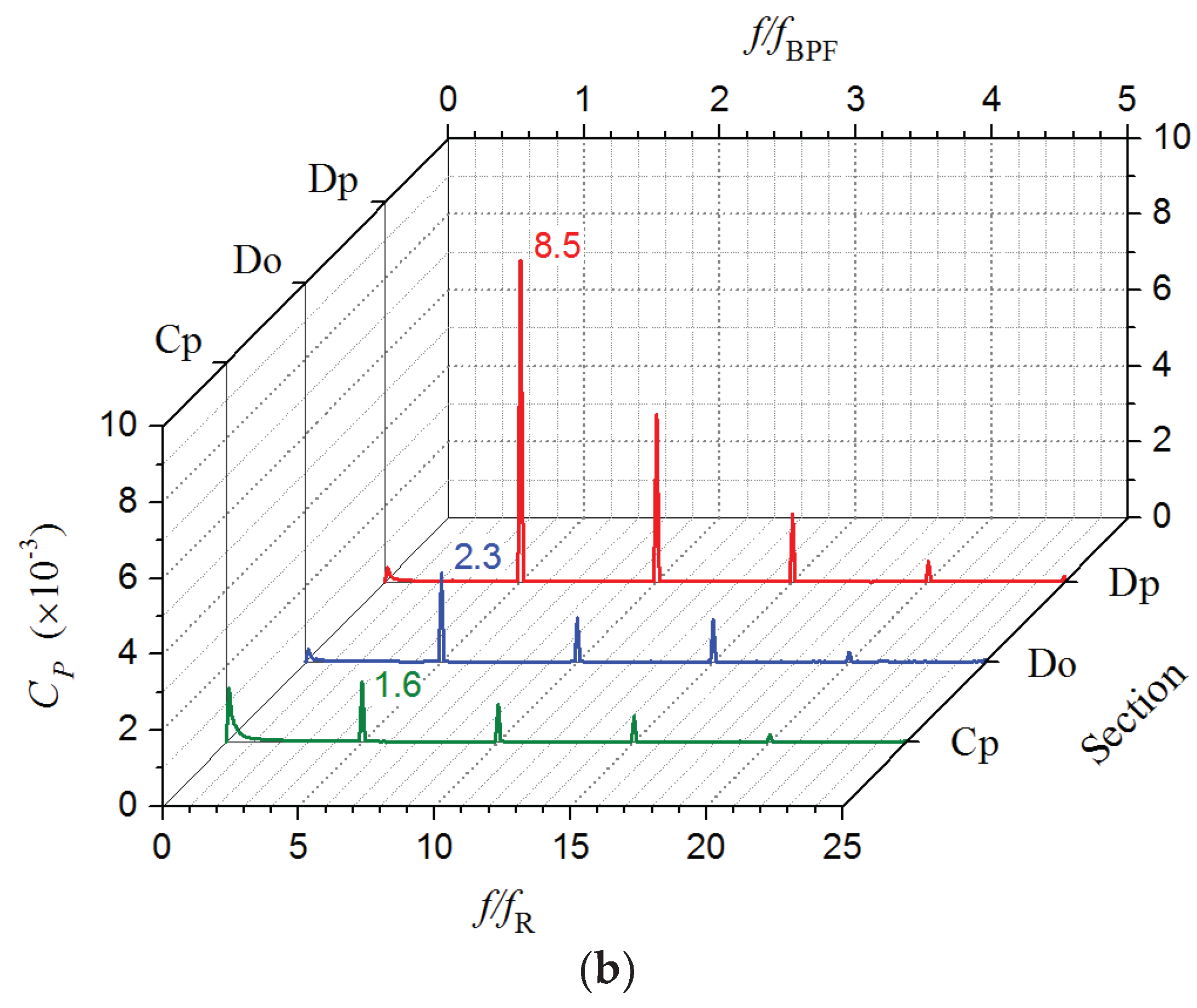5.1. Experimental Validation
The hydraulic performance of Model E-S obtained by the CFD and experimental methods are shown and compared in
Figure 9. The head and efficiency are calculated on basis of the stagnation pressure difference between the suction and discharge reference sections of pump (located at the impeller inlet and pump casing outlet, respectively), which is consistent in CFD and experimental methods. The measurement errors for head and efficiency are 0.102% and 0.219%, respectively, in experiment. Nine flow rates corresponding to 30%, 50%, 70%, 80% 90%, 100%, 110%, 120%, and 130% of the design flow rate are considered in the CFD method. The head and efficiency in
Figure 9 are also expressed as the ratios to the corresponding experimental data of Model E-S at design flow rate. Overall, the CFD results of hydraulic performance are in good agreement with experimental data, especially around the design flow rate and at high flow rates. At the design flow rate, the relative CFD prediction errors for head and efficiency are 1.5% and 1.6%, respectively. Larger prediction error occurs in the part-load flow rate range (
Q <
Qd, i.e., 0.3
Qd-0.9
Qd). The head is underestimated in the hump region, while the efficiency is overestimated at minimal flow rates. These are mainly attributed to the limited capacity of the steady CFD calculation with the RANS turbulence model for predicting the complicated flow phenomena at part-load flow rate, such as the stall flow and separate flow. Nevertheless, in general, the accuracy of the CFD prediction for the hydraulic performance is acceptable within the concerned flow rate range. The CFD results of the hydraulic performance and the CFD method for steady calculation in this study are validated to be reliable.
The CFD results of the hydraulic performance shown in
Figure 9 are all obtained by the steady calculations employing the aforementioned PiMo boundary conditions (BCs, for short) scheme. However, adopting the PiMo or MiPo BCs combination almost makes no difference on the steady calculation results. The calculation results under PiMo BCs and MiPo BCs would overlap with each other in the figure at each flow rate. For this reason, those under MiPo BCs are not given herein.
Moreover, in order to validate the unsteady CFD results, the spectra of the pulsating pressure at two measuring points (M1 and M2) obtained by the CFD and experimental methods are shown together in
Figure 10. Furthermore, both the unsteady calculation results under PiMo BCs and MiPo BCs are presented herein. The frequency is expressed as the ratio to the impeller rotating frequency
fR (20.83 Hz), and the amplitude is normalized to be the pressure coefficient
CP:
where
P is the pressure (Pa),
ρ is the density of fluid (kg/m
3), and
u2m is the peripheral velocity at the mid-span of the impeller outlet (m/s).
As shown in
Figure 10, for both measuring points, the CFD method employing the PiMo BCs scheme accurately predicts the pressure pulsation components at the blade passing frequency
fBPF (5
fR), which are related to the rotor-stator interaction (RSI). In contrast, the CFD method employing the MiPo BCs scheme grossly overestimates the pressure amplitude at
fBPF for the suction measuring point M1 and entirely misses the component at
fBPF for the discharge measuring point M2. The reason for this is that, the water tank connected with pressure control unit is arranged on the suction side of pump in experiment, as shown in
Figure 8. Consequently, setting constant pressure at the inlet as the PiMo BCs scheme is more reasonable and accordant with the actual situation in experiment. On the contrary, the false setting of the constant pressure outlet in the MiPo BCs scheme severely inhibits the pressure pulsation component at
fBPF on the discharge side of pump. This inhibiting effect is even found in the pump casing and diffuser by further comparison. Meanwhile, the overlarge pressure amplitude at
fBPF is motivated on the suction side of pump, without the actual constant pressure limit at the inlet.
Besides the components at fBPF, a mass of broadband low-frequency components (BLFCs, for short) also appear on the experimental pressure spectra, for both the measuring points. However, neither of CFD calculations under PiMo BCs and MiPo BCs accurately captures these pressure pulsation components. The BLFCs of pressure pulsation at the discharge measuring point M2 are mainly caused by the complex instable flow in the cylindrical casing which is discussed in the following section. For the instability of this chaotic flow, the realizable k-ε RANS model lacks the prediction capacity. The chaotic flow in pump casing, as well as the instable flow upstream of pump, also has a motivating effect on the BLFCs at the suction measuring point M1. Meanwhile, the chaotic instable flow also interacts with the boundary layer flow, which further makes the BLFCs of the pressure pulsation taken from the near-wall region in the experiment more complex and intense. Besides, the system instability of the test rig, unbalance of rotors due to inevitable manufacturing errors, and non-linear interactions between components are also considered to account for the BLFCs of the experimental pressure pulsation at points M1 and M2. These issues are all beyond the research capability of the CFD method used in the present paper.
Nevertheless, because the focus of this study is the unsteady flow phenomena related to the RSI (with frequencies as fBPF and the upper harmonics), the unsteady calculation results under PiMo BCs, which agree quite well with the experimental data for pressure pulsation components at fBPF, are considered acceptable. On the other side, because the measuring points are located relatively far away from the impeller, the pressure pulsation components at fBPF of them are severely attenuated. Actually, in the more crucial and concerned region around the impeller, the component at fBPF is overwhelmingly dominant for pressure pulsation and dynamic fluid force (see following sections). Hence, the following unsteady study on the basis of the CFD calculation results under PiMo BCs is reasonable.
5.2. Hydraulic Performance
By the steady CFD calculations employing PiMo BCs combination, the hydraulic performance of the three RCP models with different suction and discharge configurations is obtained, as shown in
Figure 9. The head curves and the efficiency curves of the three models all have the same shape. A conspicuous section with the positive slope appears in the flow rate range between 50%
Qd and 80%
Qd on the head curve. From the efficiency curves, the best efficiency point is located at the flow rate of 90%
Qd, and high efficiency was achieved from 80%
Qd to 110%
Qd.
Comparing the performance of Model E-S and Model S-S, which have the different suction configurations, the head of Model S-S (with straight suction pipe) is higher in the whole flow rate range than that of Model E-S (with an elbow on the suction side), and the efficiency of Model S-S is also higher than that of Model E-S at the overload flow rate. In the part-load flow rate range, Model S-S and Model E-S have nearly the same efficiency. In detail, at the design flow rate, the head and efficiency of Model S-S are, respectively, 2.0% and 0.5% higher than those of Model E-S. These differences in hydraulic performance between Model E-S and Model S-S mainly result from their different suction flow conditions. The axial velocity distribution on the suction flow section 0.4
DS upstream of impeller inlet (between the impeller and elbow for Model E-S) is shown in
Figure 11. After passing through the elbow, the suction flow of Model E-S becomes obviously asymmetric in the circumferential direction. A distinct flow region with low axial velocity is formed on the side in
Y direction of section center (the small-curvature side of elbow). Meanwhile, due to the existence of the distinct low-axial-velocity region, the near-wall low-velocity area of Model E-S is reduced overall, compared with that of Model S-S. Both the asymmetric axial velocity distribution and near-wall low-velocity area reduction of suction flow are detrimental to the work performing of impeller. (Existence of the near-wall low-velocity area could concentrate more flow into the main flow region of impeller instead of the tip leakage region.) Consequently, Model E-S gets the lower head. With respect to the efficiency, because the power and head of pump almost vary by the same proportion, the efficiency of these two models is nearly equivalent in the partial flow rate range. Specially, at the overload flow rate, with the rise of pump head, the flow circulation at the impeller outlet increases and the flow angles in the diffuser and casing return to be more suitable. Consequently, Model S-S with the higher head also achieves a higher efficiency at overload flow rates.
When it comes to the comparison of Model E-S and Model E-D with the different discharge configurations, in the whole flow rate range, Model E-D with the double-discharge casing achieves both the higher head and higher efficiency than Model E-S with the single-discharge casing. Furthermore, with the increase of flow rate, Model E-D gains more advantages in the head and efficiency. In detail, at the design flow rate, the head and efficiency of Model E-D is, respectively, 2.7% and 2.8% higher than those of Model E-S. The pump power of Model E-S and Model E-D is roughly the same in the whole flow rate range. The differences in head and efficiency between them are mainly due to the flow pattern change and consequent loss variation in pump casing. The flow conditions in the two pump casings are revealed in
Figure 12, by means of the streamlines and velocity distribution on the middle axial section. The arrows indicate the flow direction and the color of streamline represents the magnitude of velocity. As shown, the axial flow from diffuser turns radial in the cylindrical casing. The flow rushes toward the discharge nozzle through the internal annular flow passage, actually with unceasing rolling inside as well. Due to the difference in the discharge nozzle number, different flow patterns are formed in the two casing. By comparison, due to the addition of another discharge nozzle, the flow distance in the double-discharge casing is reduced overall. Meanwhile, compared with that in the single-discharge casing, the total flow passage area in the double-discharge casing increases, which results in a significant decrease in the internal flow velocity, especially in the region near the discharge nozzle. Both the flow distance reduction and flow velocity decrease in the double-discharge casing are beneficial to the loss reduction. Consequently, compared with Model E-S, Model E-D achieves a higher head and efficiency. Additionally, since the relationship between the loss in casing and the flow rate is approximately quadratic, the head and efficiency differences between Model E-D and Model E-S also increase with the flow rate.
5.3. Pressure Pulsation in Rotating Frame
For the three RCP models, the spectra of the pulsating pressure at the three monitoring points in rotating frame are compared in
Figure 13. The frequency is expressed as the ratios to the impeller rotating frequency
fR and blade passing frequency
fBPF, and the amplitude is normalized as the pressure coefficient
CP. As shown, for the pressure spectra of rotating Point Rim at the impeller inlet, those of Model E-S and Model E-D (with the same suction elbow) are almost the same. The pressure pulsation components at
fR and the harmonic frequencies of them are both obvious. In contrast, no obvious peak is observed on the pressure spectrum of Model S-S (with straight suction pipe) herein. The reason for this could be explained by the pressure distribution on the suction flow section 0.4
DS upstream of the impeller inlet. As shown in
Figure 14, downstream of the elbow, the pressure distribution on the suction flow section of Model E-S (as well as Model E-D) becomes obviously asymmetric in the circumferential direction. Overall, the pressure there gradually decreases along the positive
Y direction. A low-pressure region is formed on the side in positive
Y direction of section center (the small-curvature side of elbow), while high pressure appears on the opposite side. Furthermore, in the impeller inlet region, this asymmetric pressure distribution in fixed frame still exists. Consequently, for Model E-S and Model E-D, the point in rotating frame close to the impeller inlet, such as Point Rim, would pass through a low-pressure region and then a high-pressure region overall in a rotational cycle. As a result, the pressure pulsation at Point Rim of them is dominated by the component at
fR. Furthermore, due to the irregularity of pressure fluctuation, upper harmonic components also arise. Conversely, for Model S-S, the pressure distribution on the suction flow section is roughly uniform in the circumferential direction. Therefore, no obvious pressure pulsation in rotating frame is generated in the impeller inlet region of Model S-S.
With regard to the pressure spectra of Point Rom at the impeller outlet, those of Model E-S and Model S-S (both employing the single-discharge casing) are roughly the same, which are dominated by components at
fR and 14
fR. However, on the pressure spectrum of Model E-D, only the same spike at 14
fR is observed. The component at
fR of it almost disappears. In order to reveal the reasons, for Model E-S and Model E-D, the pressure contours at the impeller outlet (within red dashed circular rings) and those on the middle axial section of pump casing are stacked together and shown in
Figure 15. Firstly, due to the impact of diffuser, for both models, 14 pairs of alternately distributed high-pressure and low-pressure regions in the circumferential direction are observed at the impeller outlet. It is exactly this pressure distribution in the fixed frame that causes the pressure pulsation component at 14
fR in the rotating frame close to the impeller outlet. Besides the impact of diffuser, the pressure distribution at the impeller outlet is also affected by the flow condition downstream in the pump casing. In the single-discharge casing, the pressure distribution is quite uneven in the circumferential direction. Low pressure appears in the discharge nozzle region, while high pressure appears on the opposite side. Furthermore, with a certain deflection in the counter-clockwise direction due to the circumferential motion of the flow downstream of impeller, this asymmetric bipolar-opposite distribution of pressure (which has a high-pressure region on one side and a low-pressure region on the opposite side) also appears at the impeller outlet. As a result, for Model E-S and Model S-S, the component at
fR of the pressure pulsation in rotating frame is motivated in the region close to the impeller outlet. Moreover, because the pressure distribution at the impeller outlet is relatively regular, the harmonics at 2
fR~4
fR of Point Rom are not as remarkable as those of Point Rim. By contrast, in the double-discharge casing, due to the symmetry of the structure, the pressure distribution is roughly symmetric and visibly more uniform. Accordingly, the pressure distribution at the impeller outlet of Model E-D is also relatively symmetric. Consequently, no obvious pressure pulsation component at
fR arises at Point Rom which is set in the rotating frame and close to impeller outlet. In addition, for Model E-D, the double-discharge pump casing also stimulates the pressure pulsation component at 2
fR to some extent.
Within the flow passage of impeller, both the flow patterns upstream and downstream of the impeller have effects on the pressure pulsation in rotating frame. For Model E-D, the pressure pulsation at Point Rpm is mainly motivated by the asymmetric suction flow related to the elbow, as that at Point Rim. Consequently, the pressure spectrum of Model E-D at Point Rpm is similar to that at Point Rim. Furthermore, the effect of the asymmetric suction flow is greater at Point Rpm than that at Point Rim. Hence, the pressure pulsation amplitudes at fR~3fR (which are related to the irregular asymmetric suction flow, as stated previously) of Point Rpm are larger than those of Point Rim. In contrast, for Model S-S, the pressure pulsation at Point Rpm is mainly motivated by the asymmetric flow downstream of impeller related to the single-discharge casing. Consequently, the pressure spectrum of Model S-S at Point Rpm is similar to that at Point Rom apart from 14fR. Furthermore, the effect of the downstream asymmetric flow is weakened at Point Rpm, compared with that at Point Rom. Hence, the pressure pulsation amplitude at fR (which are related to the downstream asymmetric flow) of Point Rpm is smaller than that of Point Rom. For Model E-S, both the asymmetric suction flow and asymmetric flow downstream of impeller have motivating effects on the pressure pulsation at Point Rpm. Furthermore, because the phase difference between the asymmetric pressure distribution at the impeller inlet and outlet is just close to the blade wrap angle, the pressure pulsation component at fR of Model E-S is greatly enhanced at Point Rpm. Besides, within the flow passage of impeller, the effect of diffuser on the pressure pulsation in rotating frame is severely weakened. Thus, unlike those of Point Rom, no obvious component at 14fR was observed on the spectra of Point Rpm.
Overall, for the axial-flow RCP, the variation of the suction and discharge configurations greatly affects the pressure pulsation in rotating frame. As stated above, all the circumferentially non-uniform flow patterns related to the stationary components upstream and downstream would motivate the corresponding components of pressure pulsation in the rotating frame of impeller. Compared with the suction pipe with elbow and the single-discharge casing, respectively, the straight suction pipe of Model S-S and the double-discharge casing of Model E-D result in more uniform flow upstream and downstream of impeller. Consequently, the pressure pulsation in the rotating frame of Model S-S and Model E-D is reduced overall in the impeller region, compared with that of Model E-S. The pressure pulsation in rotating frame actually reveals and evaluates the impacts of stationary components on the rotating impeller region which are the one aspect of RSI. The above results show that, for the axial-flow RCP, the unsteady flow field in the rotating frame around impeller is affected by all the stationary components, not only the diffuser but also the suction elbow and cylindrical pump casing. The RSI, which plays a significant role in the unsteady flow phenomena, exists not only between the impeller (rotor) and diffuser (stator). In fact, the generalized RSI exists between the rotating impeller and all stationary components that cause circumferentially non-uniform flow. Or rather, the RSI is actually the interaction between the rotating circumferentially non-uniform flow field of impeller and the fixed one related to the stationary components. The results also indicate that, the straight suction pipe of Model S-S and the double-discharge casing of Model E-D, which respectively make the flow fields upstream and downstream more uniform in the circumferential direction, have less interference to the rotating flow field of impeller. Consequently, compared with that in Model E-S, the RSIs in Model S-S and Model E-D are weakened in different degrees. Improving the circumferential uniformity of flow fields upstream and downstream of the impeller region contributes to the reduction of RSI in the axial-flow RCP.
5.4. Pressure Pulsation in Fixed Frame
In order to get an overall view of the pressure pulsation in the fixed frame, the pressure spectra of fixed monitoring points are averaged on each axial section (see
Figure 6). As an example, the obtained average pressure spectra of Model E-S on the six sections are shown in
Figure 16. As shown, the pressure spectra are all dominated by components at the blade passing frequency
fBPF (5
fR) and its harmonic frequencies. Because the pressure pulsation in fixed frame is mainly caused by the rotating of the impeller with 5 equispaced blades and uneven flow field around. The pressure pulsation (of monitoring points in the blade tip clearance) on Section Itc in the middle of impeller (main exciting source) is the strongest of all, which is related to the huge pressure difference between the blade tip gap and flow passage of impeller. Moreover, due to the complex flow condition in the tip leakage region, the amplitudes of harmonics at 2
fBPF~5
fBPF on Section Itc are still quite large (unlike those on the other sections). From here on, the pressure pulsation components at
fBPF and upper harmonic frequencies gradually attenuate upstream and downstream. The pressure pulsation on Section Ii at the impeller inlet is still very strong, of which the average amplitude at
fBPF is about 30% of that on Section Itc. Whereas, on Section Io at the impeller outlet, the pressure pulsation is severely weakened, compared with that at the impeller inlet. The average pressure pulsation amplitude at
fBPF of Section Io is only about one fifth of that of Section Ii. Entering the flow passage of diffuser, the pressure pulsation on Section Dp is further weakened. Then, after passing through the diffuser, the pressure pulsation components at
fBPF and the harmonic frequencies become comparatively rather week. The average amplitudes at
fBPF of Section Do and Section Cp are approximately two orders of magnitude lower than that of Section Itc in the middle of impeller.
Moreover, in order to investigate the effects of suction and discharge conditions on the pressure pulsation, the average pressure pulsation amplitudes at
fBPF on each section of the three RCP models are compared in
Figure 17. For ease of comparison, on each section, the average pressure pulsation amplitudes are expressed as the Relative
CP, which is the ratio of
CP to that of Model E-S. As shown in
Figure 17, on Section Ii and Section Io near the impeller, the pressure pulsation amplitudes at
fBPF of the three models are without much difference. This is because, in the region close to impeller, the pressure pulsation in the fixed frame is directly affected by the rotating impeller, which is exactly unmodified in this study for the three models. Distinctively, the pressure pulsation amplitudes at
fBPF of Model S-S is slightly higher on Section Ii and Section Io. The reason for this is that, the uniform suction flow of Model S-S makes the flow distribution in the 5 flow passages of impeller more accordant, which thereby enhances the pressure pulsation component at
fBPF to a small extent. In contrast, on Section Do and Section Cp, compared with those of Model E-S, the pressure pulsation amplitudes at
fBPF of Model S-S and Model E-D become obviously smaller, especially for those of Model S-S and those on Section Cp which is comparatively far away from the impeller. On Section Cp, the average amplitudes at
fBPF of Model S-S and Model E-D are 36.5% and 87.3% of that of Model E-S, respectively. The pressure pulsation in fixed frame reflects the other aspect of the RSI, i.e., the impact of rotating impeller on the stationary flow field. Thus, this difference considered to be related to the weakened RSI between the impeller and straight suction pipe in Model S-S, as well as that (the weakened RSI) between the impeller and double-discharge casing in Model E-D. Nevertheless, the absolute difference of pressure pulsation amplitude among the three models on Section Do and Section Cp is actually not large, because the pressure pulsation is quite weak there, as that of Model E-S shown in
Figure 16. Hence, for the axial-flow RCP, the variations of suction and discharge conditions studied in this article overall have no significant effect on the pressure pulsation in fixed frame.
5.5. Dynamic Fluid Force
The dynamic fluid force is another important unsteady flow phenomenon, which plays a more direct role in the vibration and noise inducing of pump. Among the dynamic fluid forces, those radially acting on the impeller are particularly significant and critical. Herein, for the three RCP models with different suction and discharge configurations, the spectra of the radial dynamic fluid forces acting on impeller are obtained and compared in
Figure 18. The direction of forces is defined in accordance with the coordinate system specified in
Figure 5, and the amplitude is normalized as the force coefficient
CF:
where
F is the force (N),
D2m is the diameter at the mid-span of impeller outlet (m), and
b2 is the width of impeller outlet (m).
As shown in
Figure 18, the components of radial dynamic fluid forces are mainly at
fBPF, 2
fBPF, and 3
fBPF on every spectrum. The force amplitudes at 3
fBPF of the three models are basically the same (merely those of Model S-S are slightly larger). The difference among the three models is mainly in the components at
fBPF and 2
fBPF. For the force amplitudes at
fBPF and 2
fBPF, those of Model E-S are the largest of all. Compared with those of Model E-S, the amplitudes of Model S-S significantly decrease at both
fBPF and 2
fBPF. The force amplitudes at
fBPF of Model S-S are only 29.1% and 27.9% of those of Model E-S in the
X and
Y directions, respectively. The force amplitudes at
fBPF of Model E-D also decrease to some extent, compared with those of Model E-S. The force amplitudes at
fBPF of Model E-D are respectively 78.0% and 79.6% of those of Model E-S in the
X and
Y directions. The force amplitudes of Model E-D are nearly equal to those of Model E-S at 2
fBPF. Additionally, there is no significant difference between the spectra of
FX and
FY. For each model, the amplitudes at
fBPF, 2
fBPF, and 3
fBPF of
FY are just a little higher than those of
FX.
From the results stated above, for the axial-flow RCP, the suction and discharge conditions also have significant effects on the radial dynamic fluid forces acting on impeller. The reason for this is considered to be related to the variation of the RSI (which would cause dynamic fluid forces with frequencies as
fBPF and the upper harmonics). As concluded in
Section 5.3, the RSI actually exists between the rotating impeller and all stationary components that cause flow to be non-uniform in circumferential direction. The RSI is basically the interaction between the rotating circumferentially non-uniform flow flied around the impeller and the fixed one related to the stationary components. The strength of the RSI is greatly affected by the circumferential uniformity of the flow fields upstream and downstream of impeller in the fixed frame. The straight suction pipe of Model S-S and the double-discharge casing of Model E-D bring more uniform flow fields and proved to have less interference to the rotating flow field of impeller. Consequently, compared with that in Model E-S, the RSIs in Model S-S and Model E-D are weakened. The radial dynamic fluid forces acting on impeller are mainly induced by the RSI. The weakening of RSI leads to the reduction of radial dynamic fluid forces. As a result, compared with those of Model E-S, the amplitudes of the radial dynamic fluid forces acting on impeller of Model S-S and Model E-D decrease at
fBPF and 2
fBPF in different degrees. Furthermore, because the suction flow of Model S-S is almost completely uniform in the circumferential direction, its amplitudes of the dynamic
FX and
FY at
fBPF and 2
fBPF become quite small. By contrast, the change of RCP casing from single-discharge to double-discharge just partially improves the circumferential uniformity of the flow field downstream of impeller. Consequently, the dynamic
FX and
FY of Model E-D only gain a minor amplitude decrease at
fBPF, compared with those of Model E-S. In addition, the further investigation indicates that, the component of radial dynamic fluid forces at 3
fBPF is mainly caused by the resonance between the impeller and diffuser. Furthermore, as mentioned previously, because the suction flow of Model S-S is almost uniform, its flow distribution in the 5 flow passages of impeller is more accordant. Therefore, the resonance between the impeller and diffuser of it is exacerbated to a small extent. This is the reason why the components of Model S-S slightly increase at 3
fBPF, compared with those of the other two models.
